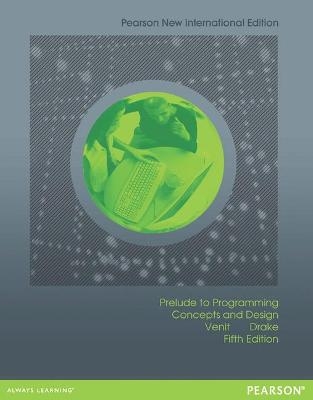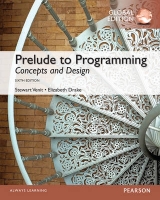
Prelude to Programming: Concepts and Design
Pearson Education Limited (Verlag)
978-1-292-04257-2 (ISBN)
- Titel erscheint in neuer Auflage
- Artikel merken
Preface xv
0 Introduction 1
In the Everyday World: Computers Everywhere 2
0.1 A Brief History of Computers 2
What Is a Computer? 2
Personal Computers 4
The Internet 7
0.2 Computer Basics 8
The Central Processing Unit 9
Internal Memory 9
Mass Storage Devices 10
Input Devices 12
Output Devices 12
0.3 Software and Programming Languages 14
Types of Software 14
Types of Programming Languages 15
Chapter Review and Exercises 18
1 An Introduction to Programming 23
In the Everyday World: You Are Already a Programmer! 24
1.1 What Is Programming? 24
A General Problem-Solving Strategy 25
Creating Computer Programs: The Program Development Cycle 26
1.2 Basic Programming Concepts 27
A Simple Program 28
Data Input 30
Program Variables and Constants 32
1.3 Data Processing and Output 35
Processing Data 35
Data Output 39
1.4 Character and String Data 43
The Declare Statement 43
1.5 Integer Data 46
Operations on Integers 47
The Binary Number System 48
Integer Representation 50
1.6 Floating Point Data 55
The Declare Statement Revisited 56
Types of Floating Point Numbers 57
Floating Point Representation 59
Chapter Review and Exercises 62
2 Developing a Program 69
In the Everyday World: Planning to Program? You Need a Plan 70
2.1 The Program Development Cycle 71
The Process of Developing a Program 71
Additional Steps in the Cycle 74
2.2 Program Design 78
Modular Programming 78
2.3 Coding, Documenting, and Testing a Program 86
Coding and Documenting a Program 87
Testing a Program 89
Types of Errors 89
2.4 Commercial Programs: Testing and Documenting 91
The Testing Phase Revisited 91
External Documentation 92
2.5 Structured Programming 94
Flowcharts 94
Control Structures 99
Programming Style 102
Chapter Review and Exercises 104
3 Selection Structures: Making Decisions 111
In the Everyday World: Decisions, Decisions, Decisions... 112
3.1 An Introduction to Selection Structures 113
Types of Selection Structures 113
Single- and Dual-Alternative Structures 114
3.2 Relational and Logical Operators 120
Relational Operators 120
Logical Operators 123
Hierarchy of Operations 128
3.3 ASCII Code and Comparing Strings 130
Representing Characters by Numbers 130
3.4 Selecting from Several Alternatives 133
Using If Structures 134
Using Case-Like Statements 137
3.5 Applications of Selection Structures 141
Defensive Programming 141
Menu-Driven Programs 144
3.6 Focus on Problem Solving: A New Car Price Calculator 147
Problem Statement 147
Problem Analysis 147
Program Design 148
Program Code 151
Program Test 151
Chapter Review and Exercises 152
4 Repetition Structures: Looping 163
In the Everyday World: Loops 164
4.1 An Introduction to Repetition Structures:
Computers Never Get Bored! 165
Loop Basics 165
Relational and Logical Operators 168
Constructing Flowcharts with a Loop Structure 169
4.2 Types of Loops 172
Pre-Test and Post-Test Loops 173
Counter-Controlled Loops 177
4.3 The For Loop 183
The For Statement 184
The For Loop in Action 187
The Careful Bean Counter 190
4.4 Applications of Repetition Structures 195
Using Sentinel-Controlled Loops to Input Data 195
Data Validation 199
The Floor() and Ceiling() Functions 203
Computing Sums and Averages 206
4.5 Focus on Problem Solving: A Cost, Revenue, and Profit Problem 211
Problem Statement 211
Problem Analysis 211
Program Design 213
Program Code 216
Program Test 216
Chapter Review and Exercises 218
5 More about Loops and Decisions 225
In the Everyday World: Advanced Loops 226
5.1 Combining Loops with If-
| Erscheint lt. Verlag | 1.11.2013 |
|---|---|
| Verlagsort | Harlow |
| Sprache | englisch |
| Maße | 216 x 274 mm |
| Gewicht | 1122 g |
| Themenwelt | Schulbuch / Wörterbuch |
| Mathematik / Informatik ► Informatik ► Theorie / Studium | |
| ISBN-10 | 1-292-04257-5 / 1292042575 |
| ISBN-13 | 978-1-292-04257-2 / 9781292042572 |
| Zustand | Neuware |
| Haben Sie eine Frage zum Produkt? |
aus dem Bereich



